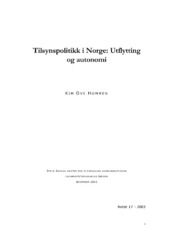| dc.contributor.author | Hommen, Kim Ove | eng |
| dc.date.accessioned | 2006-06-21T15:20:04Z | |
| dc.date.accessioned | 2020-12-10T06:31:31Z | |
| dc.date.available | 2006-06-21T15:20:04Z | |
| dc.date.available | 2020-12-10T06:31:31Z | |
| dc.date.issued | 2003-11 | eng |
| dc.identifier.issn | 1503-0946 | |
| dc.identifier.uri | https://hdl.handle.net/1956/1390 | |
| dc.description.abstract | This paper focuses on how proposals about reorganizing regulatory bodies, presented in a Government white paper (Stortingsmelding nr. 17 (2002–2003)) was initiated, explored and what kind of decisions that where made in the Parliament. The paper is based on a presumption that the choosing of procedure in formulating government policies affects political outcome. Stortingsmelding nr. 17 (2002–2003) contains three main dimensions. Those are the audit-role itself, institutional autonomy and relocation. These dimensions are in some rank all connected, but in this paper we concentrate on the two latter ones because the first dimension to a large degree disappeared in the parliament negotiations. The Bondevik II government brought new policy for regulatory agencies. Horizontal merging and cooperating among supervising authorities where to a large degree put aside. In came ideas and principles of single purpose organisations, autonomy and geographic distance. These ideas were met with heavy resistance, especially the relocation issue, but also the increase of institutional autonomy. Despite of this resistance, the Parliament accepted the relocation. At the same time increased autonomy for the supervising authorities was postponed. This paper looks into the political negotiations, the political actors, the struggle for power and the political compromise. | en_US |
| dc.description.abstract | Dette notatet fokuserer på norsk tilsynspolitikk slik den kommer til utrykk i Stortingsmelding nr. 17 (2002–2003) om statlig tilsyn. I notatet beskrives og analyseres initiativfasen, utredningsfasen og vedtaksfasen i arbeidet med meldingen. Notatet bygger videre på en antakelse om at regjeringens organisering av dette arbeidet er viktig for å forstå både innholdet i meldingen, stortingsbehandlingen og utfallet i saken. Tilsynsmeldingen inneholder hovedsakelig tre dimensjoner, selve tilsynsrollen, tilsynenes autonomi og geografisk relokalisering. Selv om dimensjonene til en hvis grad henger sammen er dette notatet hovedsakelig konsentrert om de to siste, mest på grunn av at selve tilsynsrollen ble lite fokusert på i vedtaksfasen. Med Tilsynsmeldingen ble tidligere politiske signaler i retning av horisontal samordning av tilsynsorganer lagt vekk og erstattet med prinsipper om rendyrking, autonomi og geografisk avstand. Regjeringen møtte på flere områder massiv motstand, særlig i forhold til å flytte ut en rekke tilsyn fra Oslo-regionen. Likevel endte Stortinget med å vedta utflyttingen mens forslagene om å øke tilsynenes autonomi ble borte i en politisk avtale. Det legges i den sammenheng vekt på å kartlegge de politiske forhandlingene, aktørene, maktkampen og kompromissene. Et hovedformål er å vise dynamikken mellom politiske arbeidsmetoder og politiske beslutninger. | no |
| dc.format.extent | 526958 bytes | eng |
| dc.format.mimetype | application/pdf | eng |
| dc.language.iso | nob | eng |
| dc.publisher | Stein Rokkan Centre for Social Studies | eng |
| dc.relation.ispartofseries | 17-2003 | |
| dc.relation.ispartofseries | Notat | no |
| dc.title | Tilsynspolitikk i Norge: Utflytting og autonomi | nob |
| dc.type | Working paper | eng |
| dc.subject.nsi | VDP::Samfunnsvitenskap: 200 | nob |
